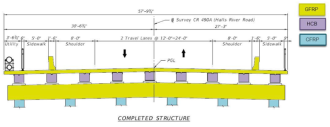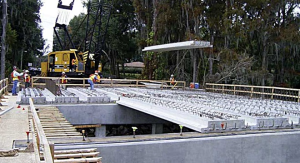Corrosion is a constant concern for the Florida Department of Transportation (FDOT). Due to the aggressive environment in Florida – high humidity, high temperatures, high water tables, and high exposure to salt water – maintenance of the steel or steel-reinforced concrete parts of bridges can become very expensive. An FDOT study of 54 bridge projects in District 7 showed that corrosion was responsible for three quarters of maintenance costs on average.
In response, FDOT is constantly seeking materials and design advances that reduce costs across the lifetime of a bridge. The Halls River Bridge in Homasassa Springs, FL, is being used to test a variety of new technologies that address maintenance and longevity issues. The FAMU-FSU College of Engineering and the University of Miami College of Engineering have teamed up to monitor every aspect of this project, including fabrication, construction, and installation of experimental technologies.
In a quiet part of Florida’s scenic west coast, the Halls River empties into the Homosassa River in the few miles between Homosassa Springs and the Gulf of Mexico. Near the junction of the two rivers, the Halls River is spanned by a 180-foot-long bridge that provides the only connection between the town of Homosassa Springs and the northern half of the town of Homosassa.
The current structure was built in 1954, and due to significant deterioration, is being replaced. It was an ideal candidate for implementation of corrosion-free structural elements as part of FDOT’s Invitation-for-Innovation initiative which focuses on developing structural applications for fiber-reinforced polymers (FRP), a class of corrosion-free materials that have been extensively tested in FDOT’s research program.
 From the pilings to the deck and everything in between, every part of the new bridge includes some type of FRP element. The concrete piles that support the bridge are prestressed with carbon fiber composite cables (CFCC). The hybrid composite beams (HCB) that will support the bridge deck have been used in a dozen bridges nationally, but these will be the first in Florida. Glass-fiber-reinforced polymer (GFRP) will find multiple uses in the new bridge – in the guard rails, the pier caps, the bridge deck, and as reinforcement in the CFCC-prestressed sheet piles that serve as retaining walls.
From the pilings to the deck and everything in between, every part of the new bridge includes some type of FRP element. The concrete piles that support the bridge are prestressed with carbon fiber composite cables (CFCC). The hybrid composite beams (HCB) that will support the bridge deck have been used in a dozen bridges nationally, but these will be the first in Florida. Glass-fiber-reinforced polymer (GFRP) will find multiple uses in the new bridge – in the guard rails, the pier caps, the bridge deck, and as reinforcement in the CFCC-prestressed sheet piles that serve as retaining walls.

The new Halls River Bridge will also use several green concrete products in combination with noncorrosive reinforcement. The bulkhead caps will be cast with SEACRETE, which has identical mixture properties to conventional concrete but fresh water is replaced with seawater and a retarder to offset the high chloride content. In addition to being more environmentally friendly, SEACRETE shows higher early age strength than conventional concrete mixtures.
In addition to SEACRETE, a Green-RAP and a Green-RCA concrete mix will be used in components of the Halls River Bridge. In Green-RAP concrete, recycled asphalt pavement (RAP) partially replaces the aggregate while Green-RCA concretes use recycled concrete aggregate. Test blocks in varying combinations of SEACRETE, Green-RAP, and Green-RCA concretes will also be cast to monitor the performance of different concrete mixtures in real world conditions.
FAMU-FSU College of Engineering and the University of Miami College of Engineering will closely monitor each phase of the fabrication and construction of the bridge. In addition, the bridge will be equipped with sensors which will allow the researchers to monitor the performance of the bridge’s components.

Construction costs for the new Halls River Bridge are about 30% higher than traditional concrete and steel construction. But these additional initial costs are expected to be effectively paid back in significant savings on maintenance and extended service life, which is expected to exceed the 75-year service life that FDOT requires for all new bridges.
“This [bridge project] has transformed into a showcase of technology, from the piles to the caps to the deck to the railing,” says Antonio Nanni, chair of the engineering college at the University of Miami. “This project is an example of how to make FRP-concrete structures – including piles, beams, seawalls and decks – that are more durable, stronger and safer than today’s construction.”
Further Reading
- FES/FICE Conference Presentation
- Halls River Bridge on YouTube
- Florida Bridge Crosses into New Waters: http://compositesmanufacturingmagazine.com/2017/01/halls-river-bridge-florida-features-composites/
- University of Miami Researchers Present the World’s Most Interesting Concrete (And Rebar):
http://wlrn.org/post/university-miami-researchers-present-worlds-most-interesting-concrete-and-rebar - Halls River Bridge Getting New Tech in Makeover:
http://citrusdaily.us/story/halls-river-bridge-getting-new-tech-makeover/jun-17-2016-611pm.html
Selected FDOT Research Projects:
BDV30-977-18: Performance Evaluation of GFRP Reinforcing Bars Embedded in Concrete Under Aggressive Environments
– Research in Progress
BDV34-977-05: Degradation Mechanisms and Service Life Estimation of FRP Concrete Reinforcements
– Research in Progress
BDV31-977-01: Durability Evaluation of Florida’s Fiber-Reinforced Polymer (FRP) Composite Reinforcement for Concrete Structures
– Final Report
BDV29-977-10: Use of Fiber Reinforced Polymer Composite Cable for Post-Tensioning Applications, Phase 2
–Summary
–Final Report
BDK83-977-17: Investigation of Carbon Fiber Composite Cables (CFCC) Prestressed Concrete Piles
–Summary
–Final Report
